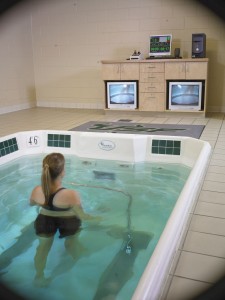Preventing & Healing ACL Injuries in Females Through the Use of Aquatics
ACL injuries have become more common in female athletes than males. More than 20,000 high school girls suffer a serious sports-related knee injury each year in the United States, according to the Chicago-based Children’s Memorial Institute for Sports Medicine. Girls are up to seven times more likely to injure their anterior cruciate ligament (ACL) than boys in similar sports.
- Wider hips
- Ligament laxity at certain stages of the menstrual cycle
- Smaller size of the notch through which the ligament connects to the femur in the upper leg
- A tendency to land straight-legged and knock-kneed
- Core instability
- Great imbalance than men in the comparative strength of the hamstring to the quadriceps or thigh muscles
Additionally, Dr. Edward Wojtys, the Director of Sports Medicine at the University of Michigan offers his opinion on the rise of ACL injuries, especially for women:
“This is more than a sports medicine problem; it’s becoming a public health problem.”*
NOVACARE Rehabilitation in Philadelphia is one facility that is proactively offering programming to help improve hip and knee strength in women for ACL recoveries, as well as, injury prevention.
FOX 29 News recently visited the Novacare facility to learn more about their ‘Prevent Injury and Enhance Performance’ program. This program focuses on injury prevention and rehabilitation for the female athlete. Dave Hill, Physical Therapist of Novacare Physical Care Rehab says ‘weak hips sink ships,” he explains that a weakness in the hips can cause injuries to other joints because all lower extremity movements stem from the hips. Therefore, there is an increased need to focus on this area to help prevent not only an ACL injury but additional injuries to the body.
With the staggering number of ACL tears every year, reportedly 150,000 for both male and female, there is an increased importance for facilities to implement not only a post-surgical program, but an injury prevention program that is focused on strengthening the hip and knee. The combination of aquatic therapy and land rehabilitation programs can play a role in successfully decreasing the frequency of this injury among all athletes.
Even top athletes like Lindsay Vonn are not immune to the commonality of this injury. In February, Vonn tore her ACL and MCL and also fractured her lateral tibia plateau after suffering a high-speed crash during the World Alpine Skiing Championship in Austria. Mo Skelton, contemplates in his article, what Vonn’s road to recovery may look like based upon others who have experienced these same injuries. This process could be comparable to the rehabilitation of other athletes suffering from similar ACL injuries.
Following an ACL surgery most athletes do not remain in a non-weight bearing status for a significant length of time. Typically activity does not come to a halt when confined to non-weight bearing status. Rehabilitation and range of motion can be increased as Skelton states “in a gravity-free environment like a HydroWorx pool. This allows activity without stressing the joints.”
Swelling at the injury or wound site is the next main area of concern after increasing range of motion and moving out of the non-weight bearing status. A few ways to manage the inflammation:
- Ice, ice baths or cold compression
- Elevation of the joint
- Light movement to get the blood flowing
- Underwater training- (the hydrostatic pressure can assist in move fluid out of the joint)
In addition to the swelling and pain caused from a traumatic injury such as this, losses of muscle strength, balance, functional strength, endurance, hip mobility and confidence are all potential consequences as well. Improving range of motion and restoring strength and stability to the joint are main goals during rehabilitation.
Water is an ideal environment to aid in this process. Early intervention with aquatic therapy can help to prevent the above side effects by reducing inflammation and allowing the athlete to begin rehab sooner than land based therapy. The warm water is a soothing, forgiving environment that decreases the pain of the patient. Improving muscle strength is also a key component to knee injury prevention and rehabilitation. Underwater treadmill exercise can greatly assist with muscle strength to further progress the rehab timeline. Research conducted at Texas A&M University showed that individuals who exercised on an underwater treadmill saw lean muscle mass increases primarily in the legs when compared to land treadmill workouts. The fear of failing and loss of confidence can also be eliminated with exercising and rehabbing in a therapy pool. We’ve found that many patients truly enjoy their time in water, which creates a positive attitude conducive to healing!
Combining the therapeutic and healing properties of water (which can be found here) with additional land- based strengthening exercises; increases the opportunity for rehabilitation success and injury prevention.
*From the NY Times Article, “For Female Athletes, A.C.L. Injuries Take Toll” written by Jere Longman.


